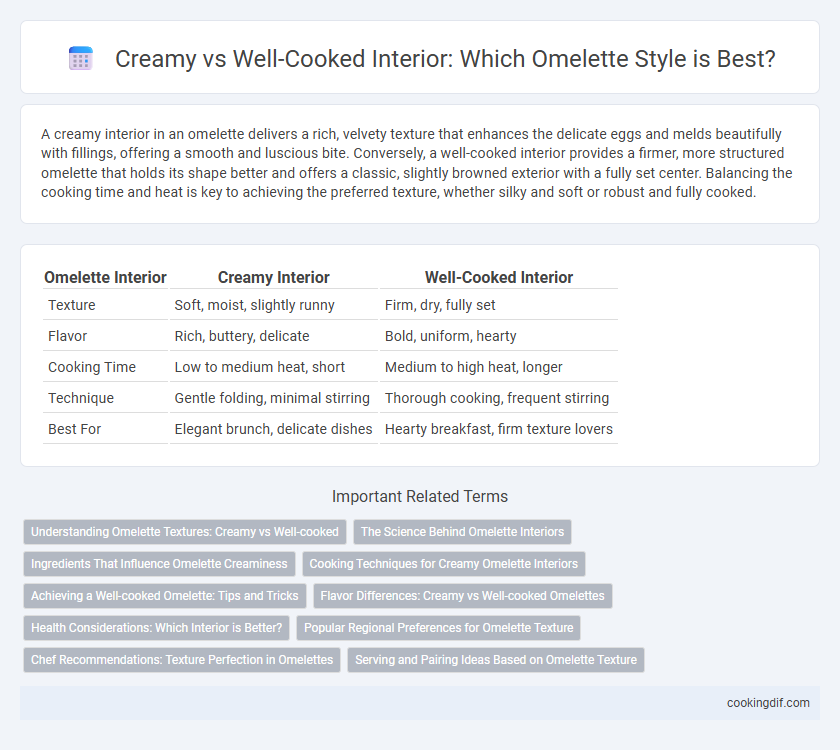A creamy interior in an omelette delivers a rich, velvety texture that enhances the delicate eggs and melds beautifully with fillings, offering a smooth and luscious bite. Conversely, a well-cooked interior provides a firmer, more structured omelette that holds its shape better and offers a classic, slightly browned exterior with a fully set center. Balancing the cooking time and heat is key to achieving the preferred texture, whether silky and soft or robust and fully cooked.
Table of Comparison
| Omelette Interior | Creamy Interior | Well-Cooked Interior |
|---|---|---|
| Texture | Soft, moist, slightly runny | Firm, dry, fully set |
| Flavor | Rich, buttery, delicate | Bold, uniform, hearty |
| Cooking Time | Low to medium heat, short | Medium to high heat, longer |
| Technique | Gentle folding, minimal stirring | Thorough cooking, frequent stirring |
| Best For | Elegant brunch, delicate dishes | Hearty breakfast, firm texture lovers |
Understanding Omelette Textures: Creamy vs Well-cooked
A creamy omelette interior is achieved by gentle, low-heat cooking, preserving moisture and resulting in a soft, custard-like texture, which enhances the richness of eggs. In contrast, a well-cooked omelette interior, cooked longer at moderate heat, offers a firmer, more set texture favored for added structure and easy folding. Mastering these techniques allows chefs to customize omelette textures, balancing taste and mouthfeel according to preference.
The Science Behind Omelette Interiors
The science behind omelette interiors involves protein coagulation and moisture retention, where a creamy interior results from gentle cooking at medium-low heat, preserving egg proteins' moisture and softness. In contrast, a well-cooked interior is achieved by higher heat or longer cooking time, causing proteins to fully denature and firm up, reducing water content and creating a tighter texture. Understanding the Maillard reaction and heat diffusion helps optimize cooking techniques for desired omelette consistency and flavor.
Ingredients That Influence Omelette Creaminess
High-quality eggs with a balanced ratio of yolks to whites significantly enhance omelette creaminess by providing richness and moisture. Adding dairy products like whole milk, cream, or cheese contributes fat and emulsifiers that create a smooth, velvety texture in the omelette interior. Incorporating ingredients such as butter and finely chopped fresh herbs further improves moisture retention and flavor, resulting in a tender and creamy omelette rather than a dry, well-cooked one.
Cooking Techniques for Creamy Omelette Interiors
Achieving a creamy interior in omelettes relies on low-heat cooking techniques that gently coagulate eggs without overcooking, preserving a soft, custard-like texture. Folding the omelette continuously during cooking ensures even heat distribution, preventing the center from solidifying too quickly. Using butter as a cooking fat adds richness and helps control temperature, creating a smooth, velvety interior instead of a dry, well-cooked one.
Achieving a Well-cooked Omelette: Tips and Tricks
Achieving a well-cooked omelette requires precise heat control and timing to ensure the interior is fully set without becoming dry or rubbery. Using medium-low heat allows the eggs to cook evenly, while gently stirring or folding helps create a uniform texture and prevents overcooking. Incorporating a small amount of butter or cream can enhance moisture and richness, resulting in a tender yet fully cooked omelette interior.
Flavor Differences: Creamy vs Well-cooked Omelettes
A creamy interior in an omelette offers a rich, velvety texture that enhances the buttery flavor and intensifies the egg's natural sweetness, delivering a luxurious mouthfeel. In contrast, a well-cooked interior produces a firmer texture that emphasizes a more robust, slightly caramelized egg flavor with subtle toasty notes. These distinct cooking styles affect the overall flavor profile, with creamy omelettes providing a delicate, smooth taste and well-cooked omelettes offering a hearty, savory experience.
Health Considerations: Which Interior is Better?
A creamy interior in an omelette retains more moisture and nutrients due to shorter cooking time, preserving vitamins like B12 and essential fats. A well-cooked interior reduces the risk of foodborne illnesses by thoroughly heating eggs, eliminating pathogens such as Salmonella. Opting for a balance between these styles ensures optimal nutrient retention and food safety for a healthier meal choice.
Popular Regional Preferences for Omelette Texture
French omelettes are prized for their creamy interior, offering a moist, tender texture that highlights the eggs' rich flavor. In contrast, American-style omelettes favor a well-cooked interior with a firmer, fully set texture that supports a variety of fillings without becoming runny. Japanese tamagoyaki embraces a slightly sweet, tightly rolled form often cooked through but still retaining a delicate softness, reflecting regional tastes for balanced texture and flavor.
Chef Recommendations: Texture Perfection in Omelettes
Chefs recommend a creamy interior for omelettes to achieve a smooth, velvety texture that enhances flavor absorption and creates a luxurious mouthfeel. A well-cooked interior results in a firmer, more structured omelette, favored for a classic presentation and ease of slicing. Balancing heat control and cooking time is essential to perfect the texture, with creamy interiors requiring gentle, low-heat cooking and well-cooked styles benefiting from moderate heat to set the eggs without drying.
Serving and Pairing Ideas Based on Omelette Texture
A creamy interior in omelettes pairs excellently with fresh, lightly dressed salads and crusty artisan bread, enhancing the rich, velvety texture and balancing the flavors. Well-cooked interiors complement heartier sides like roasted potatoes or sauteed mushrooms, providing a firmer bite that stands up to robust, savory accompaniments. Selecting accompaniments based on omelette texture elevates the overall dining experience by harmonizing mouthfeel and flavor profiles.
Creamy Interior vs Well-cooked Interior for omelette style Infographic

 cookingdif.com
cookingdif.com